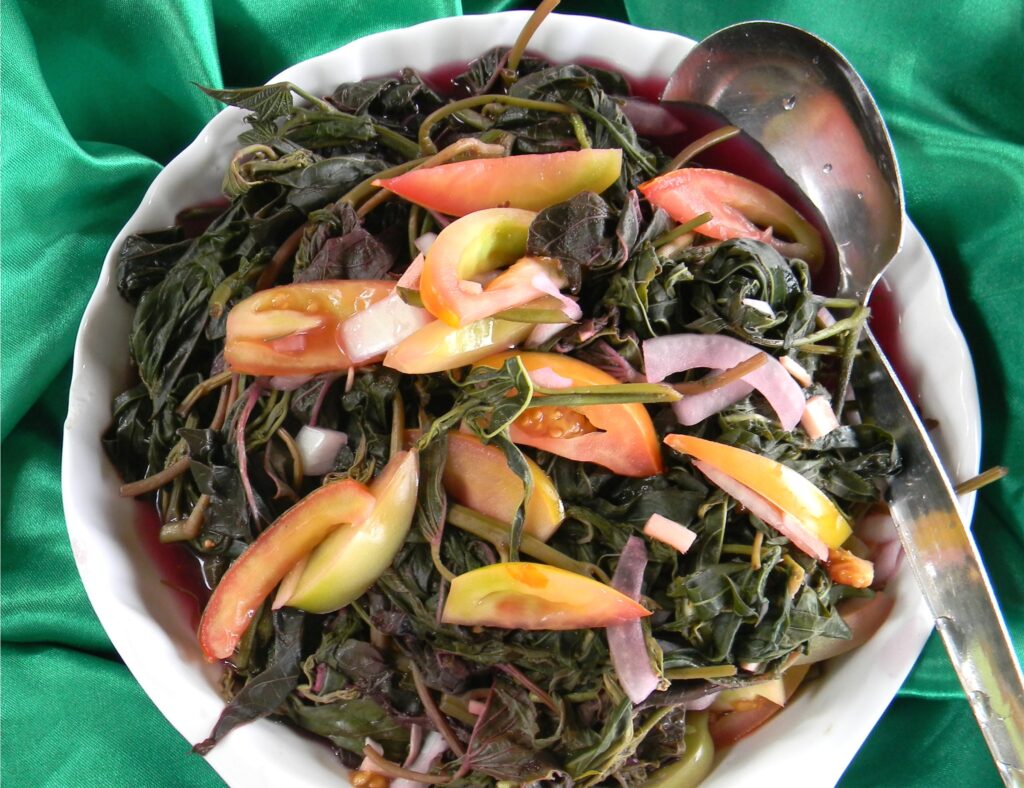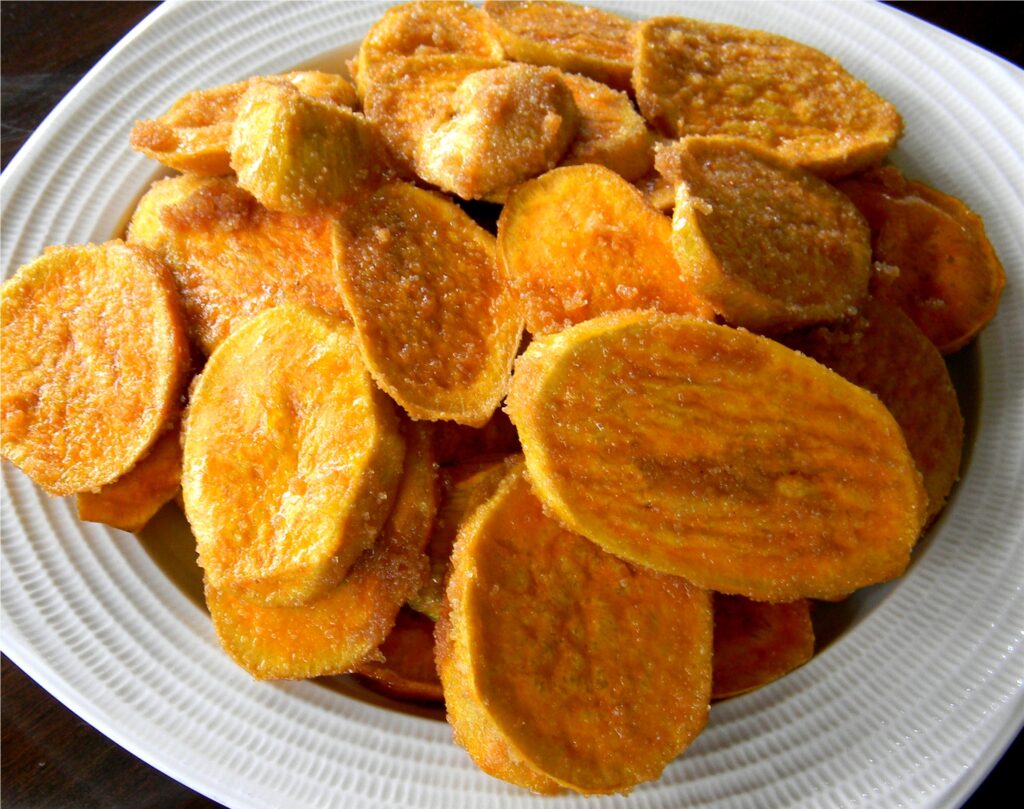Written by Henrylito D. Tacio
Sweet potato is almost always called a poor man’s crop. It is also used in a discriminatory manner; a loser is someone who is nangangamote (Filipino term for lagging behind).
But this thinking about sweet potatoes is starting to change. For people and communities affected by calamities such as drought, floods, typhoons, camote (as it is commonly known among Filipinos) is a dependable food source to tide them over the crisis.
“Camote is better than palay, mais, cassava, peanut and other crops,” a farmer said who considered it as an “all weather crop.” “It could pretty survive without fertilizer and even under bad weather conditions,” he added. “During typhoons, camote just survives, so we continuously generate income for several months compared to other crops.”
What most Filipinos don’t know is that camote is one of the most nutritious crops. The Center for Science in the Public Interest, a consumer advocacy group that focuses on nutrition and health, food safety, and alcohol policy, ranked “baked sweet potato number one in nutrition of all vegetables.”
The North Atlantic Human Nutrition Research Center on Aging considered camote as one of the world’s healthiest foods. The reason: it has the highest amounts of vitamin A among the root vegetables category. It is almost fat-free (0.39 grams).
According to the United State Department of Agriculture, for one medium size camote, you get 2.15 grams of protein, 31.56 grams of net carbs, 3.8 grams of dietary fiber, 28.6 milligrams of calcium, 16.9 milligrams of sodium, 265.2 milligrams of potassium, and 29.51 milligrams of vitamin C.
American nutritionists found that camote has “almost twice the recommended daily allowance of vitamin A, 42 percent of the recommendation for vitamin C, and four times the recommended daily allowance for beta carotene.”
A cup of cooked camote (about 200 grams) is better than broccoli and cabbage in vitamins A and C, iron, and calcium content. Because nutrients are anti-inflammatory, they help reduce the severity of asthma, osteoarthritis, and rheumatoid arthritis.

Among root crops, camote has the highest vitamin A content. Eating the yellow- or orange flesh color (directly linked to beta-carotene content) can lead to healthy skin and healthy surface linings of the eyes and the respiratory, urinary, and intestinal tracts. Vitamin A also fights infections very effectively and protects the walls of the arteries and veins against hardening.
Despite the name “sweet,” it may be a beneficial food for diabetics, as preliminary studies showed that camote has the lowest glycemic index among root crops. Research shows that sweet potato stabilizes blood glucose levels and enhances the response to insulin.
“It also digests slowly, causing a gradual rise in blood sugar (from complex carbohydrates into glucose),” writes Arlene May G. Corpus, a therapeutic dietitian at Manila Adventist Medical Center.
Corpus adds that camote is also good for those who want to lose weight. “That feeling of fullness helps control food intake,” she points out.
The roots are not the only edible part of camote but also the leaves and tops. Nutritionists claim the leaves and tops contain high amounts of antioxidants, vitamins, minerals, and dietary fiber.
In his monthly column, “Straight From the Farm,” Dr. Rafael D. Guerrero III, wrote: “In a study conducted by Chung-Yen Chen and associates of Tufts University in the United States, it was found that the purple leaves of sweet potato contained six grams of total phenolics and 21.5 grams of beta carotene per 100 grams.
“In another study by nutritionist Richard Baybutt of Kansas State University, it was reported that smokers exposed to benzoapyrene, a cancer-producing chemical in cigarettes, were deficient in vitamin A that contributed to lung inflammation and emphysema. Thus, the consumption of foods high in vitamin like camote is recommended to correct such deficiency.”
Drinking water made from camote tops has been shown to fight the dreaded dengue fever, although this has not been scientifically proven yet. A 27-year-old computer technician was reportedly downed by dengue and his platelet count plunged from 180 to 80. He was rushed by ambulance from Novaliches to Manila. Inside the ambulance, a relative, acting upon the advice of a missionary priest, made him drink juice made from camote tops. The following day, his platelet count became normal.
Here’s how the drink was prepared. Camote tops are boiled in water to extract the purple juice. The boiling lasts for about five minutes. A little salt is used to give flavor to it. The patient is made to drink slowly and gradually.

The root crop is considered to have originated from tropical America. It was brought to the Philippines by the early Spanish conquestadores. Today, camote is grown all over the country.
Camote are often a staple among impoverished families in provinces, as they are easier to cultivate and cost less than rice. The tubers are boiled or baked in coals and may be dipped in sugar or syrup. Young leaves and shoots (locally known as talbos ng kamote) are eaten fresh in salads with shrimp paste (bagoong alamang) or fish sauce (patis). They can be cooked in vinegar and soy sauce and served with fried fish (a dish known as adobong talbos ng kamote), or with recipes such as sinigang.
Watch This Video:
Now, some words of warning. “Sweet potato contains measurable amounts of oxalates that can crystallize in body fluids and cause health problems,” cautions Corpus. “If you have existing and untreated kidney or gallbladder problems, you may want to avoid eating sweet potatoes.”

